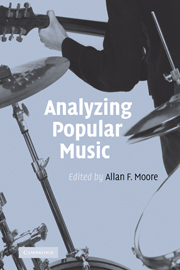Book contents
- Frontmatter
- Contents
- Acknowledgement
- Contributors
- 1 Introduction
- 2 Popular music analysis: ten apothegms and four instances
- 3 From lyric to anti-lyric: analyzing the words in pop song
- 4 The sound is ‘out there’: score, sound design and exoticism in The X-Files
- 5 Feel the beat come down: house music as rhetoric
- 6 The determining role of performance in the articulation of meaning: the case of ‘Try a Little Tenderness’
- 7 Marxist music analysis without Adorno: popular music and urban geography
- 8 Jethro Tull and the case for modernism in mass culture
- 9 Pangs of history in late 1970s new-wave rock
- 10 Is anybody listening?
- 11 Talk and text: popular music and ethnomusicology
- Bibliography
- Discography
- Film/Videography
- Index
8 - Jethro Tull and the case for modernism in mass culture
Published online by Cambridge University Press: 22 September 2009
- Frontmatter
- Contents
- Acknowledgement
- Contributors
- 1 Introduction
- 2 Popular music analysis: ten apothegms and four instances
- 3 From lyric to anti-lyric: analyzing the words in pop song
- 4 The sound is ‘out there’: score, sound design and exoticism in The X-Files
- 5 Feel the beat come down: house music as rhetoric
- 6 The determining role of performance in the articulation of meaning: the case of ‘Try a Little Tenderness’
- 7 Marxist music analysis without Adorno: popular music and urban geography
- 8 Jethro Tull and the case for modernism in mass culture
- 9 Pangs of history in late 1970s new-wave rock
- 10 Is anybody listening?
- 11 Talk and text: popular music and ethnomusicology
- Bibliography
- Discography
- Film/Videography
- Index
Summary
‘You can almost sing along to it [laughs]’
Introduction
There seem to be two alternative ways to argue the presence of a modernist aesthetic in an art object. The first way would see it as a necessary response to the social conditions of modernity, as exemplified by David Harvey (Harvey 1989), such that to evade a modernistic response would be received as fraudulent. This is the essence of the position laid out by the Frankfurt theorist Theodor Adorno in his defence of Schoenberg in the face of Stravinsky, of which Adorno (1973) is the most outspoken example, and it was also adopted by such high modernist post-war composers as Boulez or Stockhausen (see Boulez 1952 and Stockhausen 1989: 140). The second way would see it as contingent, as a possible response to the social conditions of modernity, one among a number of other possibilities which could be represented, perhaps, by realism or postmodernism. Recalling Lyotard's (1988) emphasis on the historical concurrence of modernist and postmodernist responses, if the first articulation can only be identified chronologically (whereby modernity and modernism are instituted simultaneously), the second can be identified aesthetically, by assuming a series of modernist identifiers.
Idiolect in Jethro Tull
The origins of the rock band Jethro Tull can be traced back to 1966. Almost by accident they took the name of an eighteenth-century English agriculturist in 1968 (Rees 1998), and writer/vocalist Ian Anderson assumed artistic (and subsequently financial) control of the band in 1969.
- Type
- Chapter
- Information
- Analyzing Popular Music , pp. 158 - 172Publisher: Cambridge University PressPrint publication year: 2003
- 3
- Cited by



